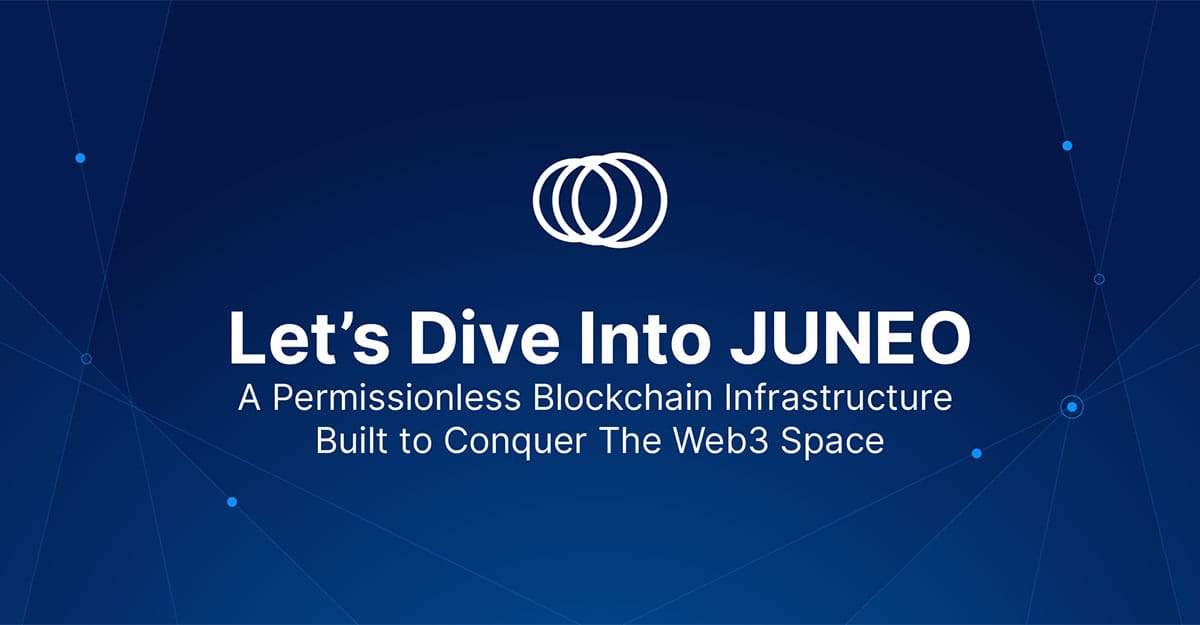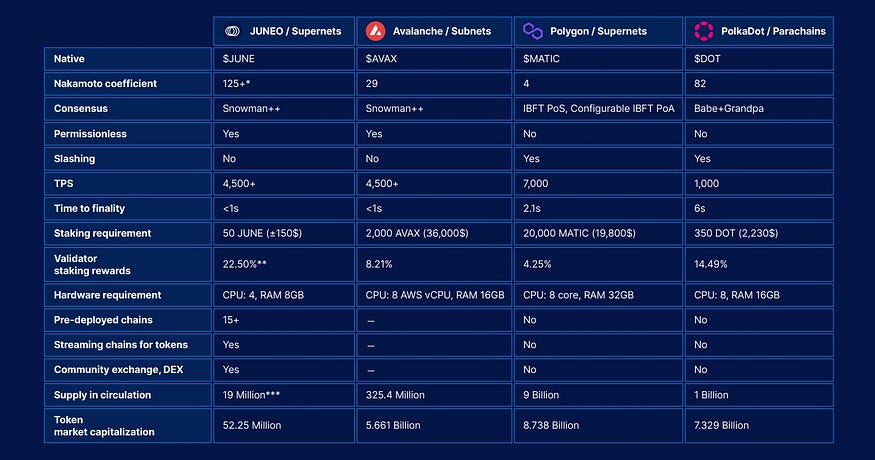A Permissionless Blockchain Infrastructure Built to Conquer The Web3 Space
Let's dive into JUNEO -A permissionless blockchain infrastructure built to conquer the Web3 space!

Blockchain technology has come a long way and has already made significant contributions to the digital space. As more and more Web2 projects are transitioning to Web3, we are also seeing an increasing adoption of blockchain technology in many areas beyond traditional finance. However, there is still a long way to go.
To bring the full benefits of this technology to all, there is a need for highly decentralized, scalable, and secure innovative projects that can connect the diverse range of blockchain networks. This is where JUNEO comes in — a new Layer 1 Modular Network that has the capacity to provide the much-needed interoperability and connectivity, thereby allowing innovation to accommodate the needs of real-world economies.
Permissionless Blockchains Are The Way Forward
In today’s fast-paced and ever-changing technological landscape, collaboration and open-source innovation are becoming increasingly important. Gone are the days of the traditional economic zero-sum gain mindset, where companies viewed others solely as competitors and kept their knowledge and technology proprietary. This restrictive approach not only slows down the pace of technological advancement, but it also stifles the growth of the company and its products, as users are unable to give their input and share their knowledge.
The new age of technology is about cooperation and collaboration, with open-source code bases leading the way.
Open-source code is the backbone of Bitcoin, Ethereum, Avalanche, and many other blockchains. From 2009, when Bitcoin Core was published, more than 100 developers from all around the world have contributed with their expertise and improved the code for the benefit of the whole community.
Permissionless blockchains have an open architecture, meaning any user can participate in the network while keeping his pseudo-anonymity. Peer-to-peer mechanisms keep the network operating without a need for a centralized intermediary. This increases the security and resilience of the network and brings maximum transparency.
Cryptocurrencies and blockchains require a decentralized way of managing their codebase, making their code public for everyone to view, change, and try out for themselves. This fosters trust in the system and encourages more people to use it, which is crucial in the relatively new and still not widely adopted world of cryptocurrencies and Web3.
To support the wider adoption and further growth of innovation in the space, JUNEO has emerged as a permissionless solution that anyone can build on top of and benefit from its high level of decentralization, lightning-fast speed and robustness.
Its open-source code is available for anyone to contribute to and test for themselves, making it a highly transparent and trustless protocol that unifies the blockchain space. The network’s flexible design allows users to protect their data while still taking advantage of a secure and decentralized layer 1 Primary Super Network that comes with all the necessary functionalities.
JUNEO’s architecture supports the creation of custom EVM Super Networks that offer companies a solution to keep their data on-chain for better communication while being able to secure its privacy. Developers can impose specific restrictions on the geolocation of validators and users or imply any rules to help the businesses stay compliant. This makes it easier for companies to configure their chain or application according to their specific needs while still benefiting from a secure and decentralized network.
Individual users can also benefit from the interoperability and decentralization JUNEO allows. Minting NFTs on different chains, making cross-chain transfers within 2 seconds, and engaging in DeFi activities on chains that do not support it are just some of the examples.
JUNEO permissionless multi-chain network is for everyone. From individual users and businesses to banks and governments. Its unique design and features grant access to the endless possibilities of blockchain technology and foster the innovation like no other project before.
A Go-to Network For Web3 Scaling
Most developers are still struggling to find the perfect solution for scaling their networks without compromising decentralization. As the number of users and transactions in Web3 grows, so does the demand for processing power, which can lead to slower transaction processing times and higher fees.
Ethereum Classic (ETC), for instance, can only process about 15 transactions per second, which is far below the demand of many decentralized applications (dApps) running on the network. As a result, ETC users may experience high fees, slow confirmations, and network congestion. This makes the user experience less favorable and hinders the wider adoption of the protocol by traditional businesses.
To address these challenges, JUNEO offers a solution that enables developers to create dApps and launch their own custom blockchains that can handle high transaction volumes without incurring high transaction fees, while still being interconnected and secured by a strong Layer 1.
JUNEO’s unique architecture and Snowman++ consensus model offers interoperability and scalability never before seen in the Web3 space, allowing users to easily interact with many different blockchains simultaneously.
Its architecture supports the creation of super networks that can offload some of the transaction processing from the main chain of ETC and other chains that struggle. Additionally, JUNEO’s strong smart contract layer could speed up the execution of smart contracts on ETC, improving the performance of dApps running on the chain. The layer is interoperable with crypto networks and ERC20 tokens, enabling seamless cross-chain transactions with automatic conversion of ERC20 tokens to the native token of the chain and vice versa. This makes JUNEO the first network with a multi-asset base layer.
Dogecoin too is limited in its scalability due to its underlying technology, but still gains large popularity. Dogecoin uses a proof-of-work (PoW) consensus mechanism, which requires miners to solve complex mathematical problems to validate transactions and add new blocks to the blockchain.
Additionally, its block size of 1 MB can limit the number of transactions that can be processed per second. This can lead to slow transaction processing times and high fees during periods of high network usage. Even though Doge has implemented some scalability improvements over the years, it’s still limited.
JUNEO can help solve the scalability issue and remove the congestion from the network. It can also bring innovation to Dogecoin and allow it to support decentralized finance (DeFi).
To support DeFi applications, blockchains must meet certain requirements such as smart contract functionality, interoperability with other chains, high scalability, low transaction fees, and security. With JUNEO’s design, users can now engage in DeFi activities on different chains, increase the speed on ETC transactions and settle in any token.
Enabling the Tokenization of Real-World Assets
Imagine the possibilities of trading hotel bookings, concert tickets, and precious metals with people all over the world, all on one unified platform. Tokenization of real-world assets (RWAs) offers this power, allowing ownership of assets to be recorded on a blockchain, providing convenience and accessibility to global markets around the clock.
Initially, blockchains introduced tokens to represent a unit of value, like Bitcoin. However, with the rise of DeFi, public blockchains have shown their true potential. DeFi applications benefit from transparency, user control, and reduced costs when compared to traditional finance. But to realize their full potential, challenges must be addressed. The trading of RWAs and their tokenization requires strict regulatory compliance and highly interconnected data to support liquidity and seamless trading.
The tokenization of RWAs can offer increased efficiency compared to the traditional model only if the blockchain layer can accommodate its demand for speed, affordability, and security.
JUNEO addresses these challenges with its highly decentralized Primary Super Network, offering supreme interoperability in the Web3 space, supported sub-second finality, and the speed of 4,500 transactions per second. Its strong smart contract layer eliminates the need for intermediaries, reducing costs and expanding the possibilities of RWAs trading. Users can make cross-chain transfers within 2 seconds and benefit from JUNEO’s innovation even on chains that do not support DeFi activities.
The base layer also supports the building of Super Networks on top to help businesses stay compliant and impose necessary restrictions, such as KYC/AML compliance, specific geolocations, and much more. Building on JUNEO is highly configurable and comes with all the necessary tools for building a marketplace, such as the chain explorer and mobile & web wallets. This significantly shortens the development cycle and makes building on blockchain more affordable and accessible.
How JUNEO Expands Beyond Avalanche, Polygon and PolkaDot
While there are a few blockchains with the same goal as JUNEO, allowing interoperability and maximum scalability, JUNEO has a competitive edge in terms of performance and innovation. To gain a better understanding of how JUNEO compares to other blockchain platforms, let’s take a closer look at Avalanche, Polygon, and Polkadot.
Avalanche
Avalanche is a permissionless blockchain platform that aims to provide high scalability, security, and decentralization. It employs the Snow family consensus protocol, which enables near-instant finality and high throughput by repeatedly sampling the network to reach consensus. The Snow protocols can scale millions of nodes without delegation to subsets of validators. The validators of Snow protocols can validate without continuous full membership knowledge, making them robust and permissionless. However, becoming a validator is costly and demands high hardware requirements. Despite these barriers, the validators can get an 8.21% staking reward. The minimum staking amount is 2,000 AVAX — the native token of Avalanche with a market capitalization of $5.661 billion. Nevertheless, Avalanche is highly decentralized and can reach a Nakamoto coefficient of 28.
Smart contracts on Avalanche can be written in Solidity, a popular programming language used in the Ethereum ecosystem, which enables developers to easily port their existing Ethereum contracts to the Avalanche network. The avalanche’s architecture supports interoperability with other blockchains but does not come with P-chain, X-chain and C-chain.
Polygon
Polygon, formerly known as Matic Network, is a permissioned layer 2 scaling solution for Ethereum. It provides a multi-chain infrastructure that allows developers to build and deploy decentralized applications (dApps) that are faster and cheaper than those on the Ethereum mainnet. Polygon supports the Ethereum Virtual Machine (EVM), which means that existing Ethereum smart contracts can be ported to the Polygon network.
Additionally, Polygon has its own native token, MATIC, used to pay transaction fees and participate in the network’s governance, with a market capitalization of $8.738 billion. To become a validator on Polygon, the minimum staking requirement is 20,000 Matic, and staking rewards are relatively low at 4.25%, with standard hardware requirements that come at a high cost.
Polygon uses a hybrid consensus model that combines two different types of consensus algorithms, IBFT-POS and PoA, called Configurable IBFT PoA. IBFT is a consensus algorithm where validators take turns proposing and validating blocks, and consensus is achieved through a series of rounds of voting, while PoA is a consensus algorithm that uses a set of pre-approved validators responsible for creating and validating new blocks, making it more centralized. Therefore, the network has a low Nakamoto coefficient of 4 but reaches 7,000 transactions per second, with a time to finality of 2.1 seconds. On the other hand, the deployment of subnets on Polygon is not decentralized and takes more than 20 minutes to bridge in and out. This creates barriers for a wider adoption and diminishes the overall user experience.
Polkadot
Polkadot in its essence is a permissioned blockchain that uses a sharded multichain architecture to connect multiple specialized chains, known as parachains, to a central relay chain. This allows for cross-chain communication and interoperability. However, the deployment of parachains is highly complex and is limited to 100 chains maximum.
Polkadot’s consensus algorithm, known as Nominated Proof of Stake (NPoS), permits token holders to nominate validators responsible for securing the network and processing transactions.
The minimum staking amount required to become a validator is relatively low, requiring 350 DOT — Polkadot’s native token, also used for governance. The staking rewards are an average of 14.49%, and hardware requirements for validators are CPU 8 and RAM 16GB. The native token has a market capitalization of $7.329 billion.
Polkadot is characterized by a relatively low speed, processing only 1,000 transactions per second, and a time to finality of 6 seconds. This makes it unsuitable to adopt a wider range of use cases.
JUNEO
While the mentioned three blockchain platforms aim to solve scalability and interoperability issues, they differ in their approach. Avalanche focuses on achieving high throughput and near-instant finality through its unique consensus protocol, while Polygon provides a layer 2 scaling solution for Ethereum. Polkadot, on the other hand, enables interoperability between different blockchains through its sharded multichain architecture.
JUNEO emerged as a permissionless solution that can combine the best innovation from all networks. It leverages the strong Snowman++ protocol developed by Avalanche and builds a stronger/expanded architecture on top.
It is the only network that comes with 20+ pre-deployed chains, allowing greater interoperability and decentralization. The Nakamoto Coefficient is set at 125 within the first 6 months and is expected to reach 300 at the maturity stage as more chains and validators join the network. With a relatively low token supply and a minimum staking requirement of 50 JUNE tokens, tokens are better spread across the validators, allowing JUNEO to reach such numbers. Additionally, hardware requirements for validators are lowered, making blockchain technology more accessible.
The JUNE token itself also comes with some advantages over the native tokens of the aforementioned chains. It is a sustainable utility token used for paying network fees, rewarding validators and governance for the JUNEO Network. It is a EIP-1559 token and can be used with EVM compatible wallets. It is capped at 45 million tokens, a significantly lower value when compared to the other chains. This scarcity makes it a good store of value and further enhances the Network.

Permisionless blockchains are the only way forward. Polkadot sacrifices decentralization right at the base layer, while Polygon is a fully permissioned chain, not allowing the users to benefit from all the innovation blockchain technology has brought. While these networks support cross-chain transfers, they are not efficient and often come at a high cost. The core idea of blockchain is to be decentralized and available to anyone to join. There can be no compromise when it comes to maintaining affordable costs and ensuring a smooth user experience.
JUNEO presents notable advantages when compared to other blockchain networks:
- Fully decentralized and permisionless
- Leveraging the strong Snowmann++ consensus
- High Nakamoto coefficient of 125 at launch with the potential to reach 300 at maturity
- Sub second finality and 4,500 TPS
- Affordable staking requirements and high validator staking rewards — 22,50% on average for the first 5 years
- The only chain that comes with 20+ pre-deployed chains
- Smooth cross-chain transfers in just 2 seconds and reduced bridge withdrawals times to less than 5 seconds
- High composability with native chain messaging, ERC20-to-Native conversion and vice versa
- Sustainable tokenomics with only 19 million JUNE tokens in circulation
JUNEO emerges as a solution to address the shortcomings observed in other blockchain networks. By consolidating the finest features of blockchain technology within a single ecosystem, JUNEO establishes itself as a robust modular-chain layer 1&2 network, enabling limitless blockchain creation. It is suitable to accommodate the needs of traditional finance, individual crypto enthusiasts and developers looking for an affordable and safe environment for their apps.
Its permissionless nature allows anyone to test and see for themselves the innovation brought by the JUNEO team. Take advantage of the Socotra Testnet and harness the full potential of blockchain technology!

